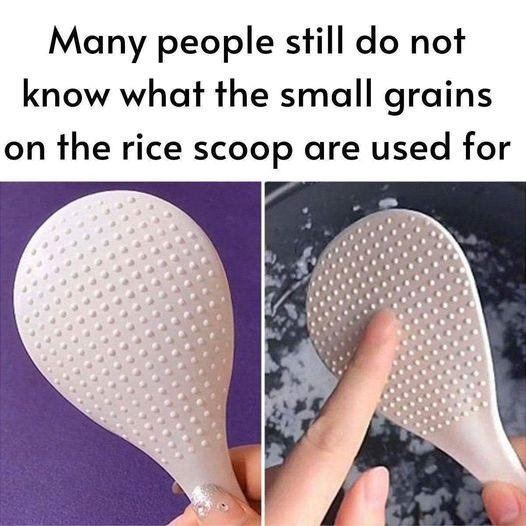ADVERTISEMENT
The Mystery Behind the Small Grains on the Rice Scoop: What Are They and Why Are They Important?
When preparing rice, one of the most common kitchen tools is the rice scoop. Most people use it to measure or serve the rice, but if you’ve ever looked closely at the rice scoop after using it, you might have noticed something curious: small grains of rice seem to accumulate on the scoop. For many, these little grains are an afterthought—unnoticed or discarded without a second thought. However, there is more to these small grains than you might think. So, what are they, and why should we care?
What Are These Small Grains?
The small grains that often stick to your rice scoop are typically “broken grains” of rice. They are pieces of rice that have fractured or broken during harvesting, milling, or handling. During the rice milling process, when the rice is polished, some grains inevitably break due to the mechanical force. These broken grains are smaller, less uniform, and are often separated from the whole rice during packaging.
Why Do They Matter?
At first glance, broken grains might seem like a waste or a flaw in the rice. However, they can play an important role in the rice preparation process. Here are a few reasons why they matter:
- Texture and Cooking Properties: Broken grains may cook slightly differently than whole grains. They tend to absorb water more quickly, and they may produce a slightly different texture. Some rice dishes, such as congee or rice porridge, actually benefit from the inclusion of these smaller grains, as they help create a creamier consistency.
- Nutritional Content: Broken grains still contain many of the nutrients found in whole grains, including fiber, vitamins, and minerals. In some cases, these grains may even contain more nutrients, as the outer layers of the rice, which are rich in nutrients, are exposed more than in whole grains. So, these small grains are just as nutritious as their intact counterparts.
- Economic Benefits: For many consumers, broken grains are sold at a lower price than whole rice. This can make rice more affordable for families or in regions where cost is a significant concern. This is particularly true in countries where rice is a staple food, and providing affordable options is important.
- Potential for Creativity in Cooking: While broken grains might be seen as a byproduct of the rice milling process, they can be an opportunity for creativity in the kitchen. In certain recipes, such as rice cakes or rice flour, broken rice can be used as a key ingredient. The smaller size of the grains makes them ideal for grinding into rice flour, which can be used in baking or thickening soups and sauces.
- For Complete Cooking STEPS Please Head On Over To Next Page Or Open button (>) and don’t forget to SHARE with your Facebook friends
How to Use Broken Rice Grains?
Instead of discarding those small grains on your rice scoop, consider incorporating them into your meals in the following ways:
- Congee or Rice Porridge: As mentioned earlier, broken rice is excellent for dishes like congee. The smaller grains cook down easily and create a soft, comforting texture that is perfect for breakfast or as a soothing dish when you’re feeling under the weather.
- Rice Flour: You can grind broken rice into rice flour at home using a food processor or a rice mill. This homemade rice flour can then be used in gluten-free baking or as a thickening agent in soups and sauces.
- Rice Cakes or Patties: Broken rice can be mixed with vegetables, spices, and other ingredients to create rice cakes or patties. These can be fried, baked, or grilled to make a savory snack or main dish.
- Desserts: Some cultures use broken rice in sweet dishes like rice pudding, where the smaller pieces contribute to a creamy, satisfying dessert. Try making your own version with coconut milk and a touch of sugar.
How to Minimize the Amount of Broken Grains
If you prefer to work with whole rice grains, there are a few steps you can take to minimize the amount of broken rice in your cooking:
- Handle Rice Gently: When measuring or washing rice, be gentle to avoid breaking the grains. Use a light touch when rinsing rice in water to remove excess starch, and don’t overwork the grains.
- Store Rice Properly: Store your rice in an airtight container in a cool, dry place to prevent excess moisture, which can make the rice brittle and more likely to break. Proper storage can help maintain the integrity of your rice.
- Buy Quality Rice: Look for high-quality rice that has been carefully processed with minimal breakage. Premium rice varieties are often milled with greater care, which can help reduce the number of broken grains.
Conclusion
Next time you’re preparing rice and notice those small grains on your scoop, remember that they are not just leftovers to be discarded. These broken grains may be small, but they have a big role to play in cooking and can even be a valuable ingredient in various dishes. Whether you use them to make congee, rice flour, or a creative rice patty, don’t overlook the potential of these tiny rice pieces—they’re just as nutritious and versatile as the whole grains. Embrace the beauty of broken rice, and you might discover a whole new side to your cooking!
